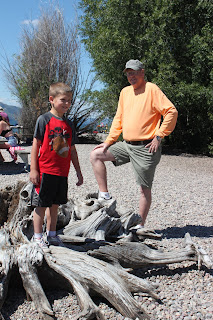Our summer in Grand Teton National Park was about as good as it gets. We both had jobs where we could walk to work, and we were out-of-doors a lot of the time. Nothing like a summer where the high temperatures are in the mid 80's (maybe a total of 20 days above 80) and with lows during the warmer weather still in the 40's. There were less than six nights when the heater in the RV did not kick on with the thermostat set on 65 for the evenings.
If you have read most of this blog you recall us mentioning Dick & Sheri from Rock Springs, Wyoming. We got to spend the summer camped near them which sure made for great times, whether it was sitting around the fire after dinner or sharing meals together. We spent about half the summer with Ron & Karen, our other friends from the Jenny Lake Store in 2010 who came back in 2011. Unfortunately, Ron had a medical issue which caused them to have to leave about halfway through the season. We cherished the time we were able to spend with people who became close friends last summer.
The last weekend we were in Wyoming, Ann checked in Bob and Michelle DuBose to the campground. Bob and Michelle worked with us last summer at the Jenny Lake Store but decided not to work this summer. We got together with them on our last night at Colter Bay for an impromptu picnic. Sheri is not in this photo because she had just left earlier in the day for her full-time job with the school system in Rock Springs. Michelle is on the left and Bob is on the right. They are from Bozeman, Montana, about 4 hours north of Colter Bay.
Now, for the summer trip numbers. It was 2,377 miles from our campsite in Colter Bay to our front door here in Gainesville, Florida, by way of visiting daughter Wendy, son-in-law Scott, and grandchildren Amelia and John in Dallas. Coming home from Wyoming, we purchased a total of 311.8 gallons of gas, ranging in price from a low of $3.29 up to $3.55 and averaged 7.55 mpg, which was an improvement over last year's 7.2 mpg. This seems high until you consider the cost of our eight nights of camping during this journey at an average cost of $28.35 per night. RVing becomes cost-effective when you compare campsite fees and meals prepared in the RV to the cost of hotel rooms and the cost of eating out all the time while traveling.
The last number is just how many days would it take to pull and the weeds that were waiting for us when we arrived home. As you can see from this photo of our backyard, some of these weeds were as high as Paul's waist. The flower pots along the back fence were empty when we left in April and now contain very tall weeds. The only green that should be seen in this photo are the azaleas on the right, but we found a back yard jungle.
In the side yard, you can't even see the pine park mulch because of all of the weeds.
These weeds were much worse than last summer. It has taken us a little over 2 weeks to pull the weeds and clean the hot tub and porch areas. We got the work done just in time to enjoy our first cool weather of the fall this past weekend with highs around 80 and evening temperatures in the mid 50's.
Thank you for joining us on our journey to the Tetons in 2011.
In the side yard, you can't even see the pine park mulch because of all of the weeds.
These weeds were much worse than last summer. It has taken us a little over 2 weeks to pull the weeds and clean the hot tub and porch areas. We got the work done just in time to enjoy our first cool weather of the fall this past weekend with highs around 80 and evening temperatures in the mid 50's.
Thank you for joining us on our journey to the Tetons in 2011.


































